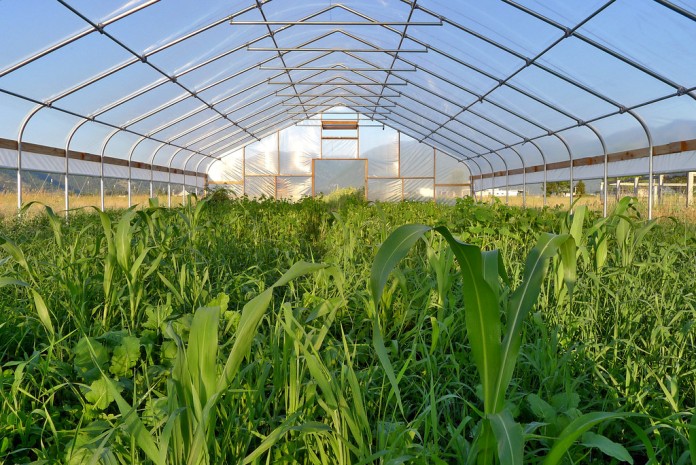Vegetables under plastic
Weighing the costs and benefits of plastic vegetable greenhouses over conventional vegetable production.
By Liza Lester, ESA communications officer
The USDA Natural Resources Conservation Service offers “seasonal high tunnel” kits as part of a three year trial to assess the potential of the plastic houses for conserving water and soil, reducing pesticide use, and improving yields for small farmers. Credit, NRCS.
THE economic benefits, for small-holders in particular, of intensive vegetable cultivation inside plastic greenhouses have driven a rapid mushrooming of long plastic tents in farmlands worldwide – but principally in China, where they cover 3.3 million hectares and produce approximately US$60 million in produce (2008 figures). In fact, 90% of all greenhouses are in China, and less than 1% of Chinese greenhouses are glass.
Covering vegetables with hoops of plastic sheeting conserves water, binds up carbon, shrinks land use, protects against soil erosion and exhaustion, and mitigates problematic dust storms. But this change from conventional vegetable farming has harmful environmental effects as well. Jie Chang and colleagues review the current research and identify gaps in our knowledge in the February issue of ESA’s journal Frontiers in Ecology and the Environment.
Plastic greenhouses are cheap, and easy to construct from locally available materials like wood, bamboo, brick, and plastic sheeting. The Chinese government encourages construction with greenhouse-friendly policies, including credit programs to cover start-up costs. The protection from the cold extends the growing season. In the temperate north, this means farmers can have two seasons, and more than double their production. Most farms (90%) in China using plastic greenhouses are small, only 0.1-0.2 hectares, and the extra money is important to farmers with low incomes. It also makes vegetables available to more people in China, particularly during the off-season.
Because the plastic catches evaporation and channels the water back to the crop, greenhouse-raised vegetables consume less water. In Shouguang Province on the northwest coast, traditional flood irrigation of conventional vegetable fields uses 8690 cubic meters of water per hectare. Farmers can reduce demand to 7049 m3ha-1 if drip irrigation is installed. Greenhouses need only 4500 m3ha-1 of water, and can get by with only 1800 m3ha-1 using drip irrigation. The difference grants a big advantage to greenhouse farmers in areas where industrial, agricultural and urban users compete fiercely for limited water resources.
The plastic cover keeps soil and water in, and some harmful airborne pollutants out. Greenhouse farmers find it more worthwhile to cycle inedible vegetable biomass back into the fields and apply manure. Greater reliance on organic fertilizers means that the soil binds up more carbon than conventional open fields. Greenhouse vegetables need less pesticide and inorganic fertilizer per unit of production than conventionally grown vegetables.
But more crops and longer growing seasons mean more water, pesticides and fertilizers are used in total, with attendant problems of soil acidification and salinization, and water quality. Plastic waste is left behind in soils, degrading soil quality and crop yields. Disease may also be concentrated under plastic. Chinese farmers usually remove plastic covers during the high summer months to reduce the disease risk.
![]() Chang, J., Wu, X., Wang, Y., Meyerson, L., Gu, B., Min, Y., Xue, H., Peng, C., & Ge, Y. (2013). Does growing vegetables in plastic greenhouses enhance regional ecosystem services beyond the food supply? Frontiers in Ecology and the Environment, 11 (1), 43-49 DOI: 10.1890/100223
Chang, J., Wu, X., Wang, Y., Meyerson, L., Gu, B., Min, Y., Xue, H., Peng, C., & Ge, Y. (2013). Does growing vegetables in plastic greenhouses enhance regional ecosystem services beyond the food supply? Frontiers in Ecology and the Environment, 11 (1), 43-49 DOI: 10.1890/100223
